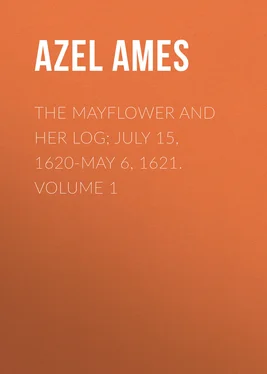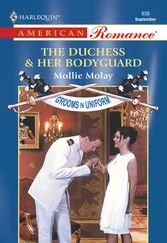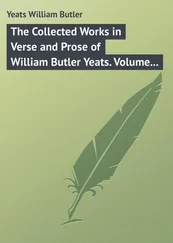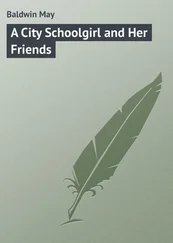Azel Ames - The Mayflower and Her Log; July 15, 1620-May 6, 1621. Volume 1
Здесь есть возможность читать онлайн «Azel Ames - The Mayflower and Her Log; July 15, 1620-May 6, 1621. Volume 1» — ознакомительный отрывок электронной книги совершенно бесплатно, а после прочтения отрывка купить полную версию. В некоторых случаях можно слушать аудио, скачать через торрент в формате fb2 и присутствует краткое содержание. Жанр: foreign_prose, История, foreign_edu, foreign_antique, на английском языке. Описание произведения, (предисловие) а так же отзывы посетителей доступны на портале библиотеки ЛибКат.
- Название:The Mayflower and Her Log; July 15, 1620-May 6, 1621. Volume 1
- Автор:
- Жанр:
- Год:неизвестен
- ISBN:нет данных
- Рейтинг книги:4 / 5. Голосов: 1
-
Избранное:Добавить в избранное
- Отзывы:
-
Ваша оценка:
- 80
- 1
- 2
- 3
- 4
- 5
The Mayflower and Her Log; July 15, 1620-May 6, 1621. Volume 1: краткое содержание, описание и аннотация
Предлагаем к чтению аннотацию, описание, краткое содержание или предисловие (зависит от того, что написал сам автор книги «The Mayflower and Her Log; July 15, 1620-May 6, 1621. Volume 1»). Если вы не нашли необходимую информацию о книге — напишите в комментариях, мы постараемся отыскать её.
The Mayflower and Her Log; July 15, 1620-May 6, 1621. Volume 1 — читать онлайн ознакомительный отрывок
Ниже представлен текст книги, разбитый по страницам. Система сохранения места последней прочитанной страницы, позволяет с удобством читать онлайн бесплатно книгу «The Mayflower and Her Log; July 15, 1620-May 6, 1621. Volume 1», без необходимости каждый раз заново искать на чём Вы остановились. Поставьте закладку, и сможете в любой момент перейти на страницу, на которой закончили чтение.
Интервал:
Закладка:
(c) The establishment as correct, beyond reasonable doubt, of the date, Sunday, June 11/21, 1620, affixed by Robert Cushman to his letter to the Leyden leaders (announcing the "turning of the tide" in Pilgrim affairs, the hiring of the "pilott" Clarke, etc.), contrary to the conclusions of Prince, Arber, and others, that the letter could not have been written on Sunday.
(d) The demonstration of the fact that on Saturday, June 10/20, 1620, Cushman's efforts alone apparently turned the tide in Pilgrim affairs; brought Weston to renewed and decisive cooperation; secured the employment of a "pilot," and definite action toward hiring a ship, marking it as one of the most notable and important of Pilgrim "red- letter days."
(e) The demonstration of the fact that the ship of which Weston and Cushman took "the refusal," on Saturday, June 10/20, 1620, was not the MAY-FLOWER, as Young, Deane, Goodwin, and other historians allege.
(f) The demonstration of the fact (overthrowing the author's own earlier views) that the estimates and criticisms of Robinson, Carver, Brown, Goodwin, and others upon Robert Cushman were unwarranted, unjust, and cruel, and that he was, in fact, second to none in efficient service to the Pilgrims; and hence so ranks in title to grateful appreciation and memory.
(g) The demonstration of the fact that the MAY-FLOWER was not chartered later than June 19/29, 1620, and was probably chartered in the week of June 12/22—June 19/29 of that year.
(h) The addition of several new names to the list of the Merchant Adventurers, hitherto unpublished as such, with considerable new data concerning the list in general.
(i) The demonstration of the fact that Martin and Mullens, of the MAY- FLOWER colonists, were also Merchant Adventurers, while William White was probably such.
(j) The demonstration of the fact that "Master Williamson," the much- mooted incognito of Bradford's "Mourt's Relation" (whose existence even has often been denied by Pilgrim writers), was none other than the "ship's-merchant," or "purser" of the MAY-FLOWER,—hitherto unknown as one of her officers, and historically wholly unidentified.
(k) The general description of; and many particulars concerning, the MAY- FLOWER herself; her accommodations (especially as to her cabins), her crew, etc., hitherto unknown.
(1) The demonstration of the fact that the witnesses to the nuncupative will of William Mullens were two of the MAY-FLOWER'S crew (one being possibly the ship's surgeon), thus furnishing the names of two more of the ship's company, and the only names—except those of her chief officers—ever ascertained.
(m) The indication of the strong probability that the entire company of the Merchant Adventurers signed, on the one part, the charter-party of the MAY-FLOWER.
(n) An (approximate) list of the ages of the MAY-FLOWER'S passengers and the respective occupations of the adults.
(o) The demonstration of the fact that no less than five of the Merchant Adventurers cast in their lots and lives with the Plymouth Pilgrims as colonists.
(p) The indication of the strong probability that Thomas Goffe, Esquire, one of the Merchant Adventurers, owned the "MAY-FLOWER" when she was chartered for the Pilgrim voyage,—as also on her voyages to New England in 1629 and 1630.
(q) The demonstration of the fact that the Master of the MAY-FLOWER was Thomas Jones, and that there was an intrigue with Master Jones to land the Pilgrims at some point north of the 41st parallel of north latitude, the other parties to which were, not the Dutch, as heretofore claimed, but none other than Sir Ferdinando Gorges and the Earl of Warwick, chiefs of the "Council for New England," in furtherance of a successful scheme of Gorges to steal the Pilgrim colony from the London Virginia Company, for the more "northern Plantations" of the conspirators.
(r) The demonstration of the fact that a second attempt at stealing the colony—by which John Pierce, one of the Adventurers, endeavored to possess himself of the demesne and rights of the colonists, and to make them his tenants—was defeated only by the intervention of the "Council" and the Crown, the matter being finally settled by compromise and the transfer of the patent by Pierce (hitherto questioned) to the colony.
(s) The demonstration of the actual relations of the Merchant Adventurers and the Pilgrim colonists—their respective bodies being associated as but two partners in an equal copartnership, the interests of the respective partners being (probably) held upon differing bases—contrary to the commonly published and accepted view.
(t) The demonstration of the fact that the MAY-FLOWER—contrary to the popular impression—did not enter Plymouth harbor, as a "lone vessel," slowly "feeling her way" by chart and lead-line, but was undoubtedly piloted to her anchorage—previously "sounded" for her—by the Pilgrim shallop, which doubtless accompanied her from Cape Cod harbor, on both her efforts to make this haven, under her own sails.
(u) The indication of the strong probability that Thomas English was helmsman of the MAY-FLOWER'S shallop (and so savior of her sovereign company, at the entrance of Plymouth harbor on the stormy night of the landing on Clarke's Island), and that hence to him the salvation of the Pilgrim colony is probably due; and
(v) Many facts not hitherto published, or generally known, as to the antecedents, relationships, etc., of individual Pilgrims of both the Leyden and the English contingents, and of certain of the Merchant Adventurers.
For convenience' sake, both the Old Style and the New Style dates of many events are annexed to their mention, and double-dating is followed throughout the narrative journal or "Log" of the Pilgrim ship.
As the Gregorian and other corrections of the calendar are now generally well understood, and have been so often stated in detail in print, it is thought sufficient to note here their concrete results as affecting dates occurring in Pilgrim and later literature.
From 1582 to 1700 the difference between O.S. and N.S. was ten (10) days (the leap-year being passed in 1600). From 1700 to 1800 it was eleven (11) days, because 1700 in O.S. was leap-year. From 1800 to 1900 the difference is twelve (12) days, and from 1900 to 2000 it will be thirteen (13) days. All the Dutch dates were New Style, while English dates were yet of the Old Style.
There are three editions of Bradford's "History of Plimoth Plantation" referred to herein; each duly specified, as occasion requires. (There is, beside, a magnificent edition in photo-facsimile.) They are:—
(a) The original manuscript itself, now in possession of the State of Massachusetts, having been returned from England in 1897, called herein "orig. MS."
(b) The Deane Edition (so-called) of 1856, being that edited by the late Charles Deane for the Massachusetts Historical Society and published in "Massachusetts Historical Collections," vol. iii.; called herein "Deane's ed."
(c) The Edition recently published by the Commonwealth of Massachusetts, and designated as the "Mass. ed."
Of "Mourt's Relation" there are several editions, but the one usually referred to herein is that edited by Rev. Henry M. Dexter, D. D., by far the best. Where reference is made to any other edition, it is indicated, and "Dexter's ed." is sometimes named.
AZEL AMES.
WAKEFIELD, MASSACHUSETTS,
March 1, 1901.
"Hail to thee, poor little ship MAY-FLOWER—of Delft Haven— poor, common-looking ship, hired by common charter-party for coined dollars,—caulked with mere oakum and tar, provisioned with vulgarest biscuit and bacon,—yet what ship Argo or miraculous epic ship, built by the sea gods, was other than a foolish bumbarge in comparison!"
THOMAS CARLYLECHAPTER I
Интервал:
Закладка:
Похожие книги на «The Mayflower and Her Log; July 15, 1620-May 6, 1621. Volume 1»
Представляем Вашему вниманию похожие книги на «The Mayflower and Her Log; July 15, 1620-May 6, 1621. Volume 1» списком для выбора. Мы отобрали схожую по названию и смыслу литературу в надежде предоставить читателям больше вариантов отыскать новые, интересные, ещё непрочитанные произведения.
Обсуждение, отзывы о книге «The Mayflower and Her Log; July 15, 1620-May 6, 1621. Volume 1» и просто собственные мнения читателей. Оставьте ваши комментарии, напишите, что Вы думаете о произведении, его смысле или главных героях. Укажите что конкретно понравилось, а что нет, и почему Вы так считаете.












